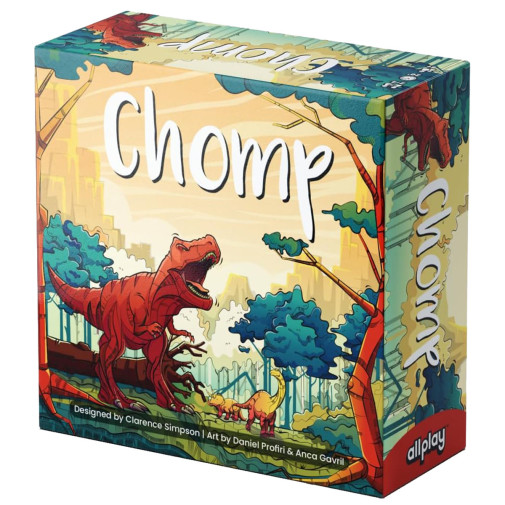We use cookies to make your experience better. To comply with the new e-Privacy directive, we need to ask for your consent to set the cookies. Learn more.
Chomp Game
Create a prehistoric environment and place its dinosaur inhabitants strategically so that they are all fed in this quick-to-teach, small box tile placement/layering game. Players take turns drawing tiles to add dinosaurs, land features, or goals that supply end-game points. The tableau tiles contain different sized carnivores and herbivore dinosaurs, tar pits, nests, plants, meat, mountain ranges and eggs. All dinosaurs need to be fed by the end of the game, or they will become extinct. Carnivores eat meat and if it is not available, they will eat herbivores of the same size or smaller, rendering them extinct. Herbivores who survive eat adjacent plants, but any dinosaur that is next to a tar pit will die. If you place a tile depicting an egg, and have a nest, you may place an egg in it to score two points at the end of the game. Once all tiles are claimed, the game ends and players score points for each dinosaur that is alive, any eggs in nests, and any earned end-game goals. The person with the most points wins! For 1-4 players with a 20-minute playtime.
The era of the dinosaurs is here! Your goal in Chomp is to form herds of dinos and make sure they are all fed. Herbivores and carnivores both need food sources, but if the carnies are not properly fed, they don't mind chomping an herbie to fill their bellies!
Gameplay involves dual rows of goal tiles and dino tiles, and each turn players select one tile to add to their personal arrangement. Goal tiles stay off to the side for endgame scoring, and dino tiles are arranged in front of each player. Dino tiles include three sizes each of herbivores and carnivores. Each tile must overlap previous ones, either on top of a quarter tile, half tile, or even a whole tile, ensuring that any covered dinos are completely hidden.
Adjacent dinos of the same species form herds, which will eat together if connected to a single food source — or die together if they are unfed, adjacent to a tar pit, or next to an otherwise unfed carnivore!
At the end of the game, each living and fed dino scores 1-3 points depending on its size, and the player with the highest score wins.
- Features vibrant colors and clear and concise scoring instruction and iconography.
- Low barrier to entry and learning curves allowing a quick and comprehensive learn to play (approximately 5 minutes or so)
- Ease of rule set allows skilled and beginners alike the opportunity to have fun and be competitive.
- Innovative card laying and tableau building lends to high replayability and interesting choices.
| Product Format: | Other |
|---|---|
| Brand: | Allplay |
| Grades: | 3-AD |
| EAN/UPC: | 618149323333 |
| Length in Inches: | 4.75 |
| Width in Inches: | 4.75 |
| Height in Inches: | 2.0625 |
| Weight in Pounds: | 0.7 |

